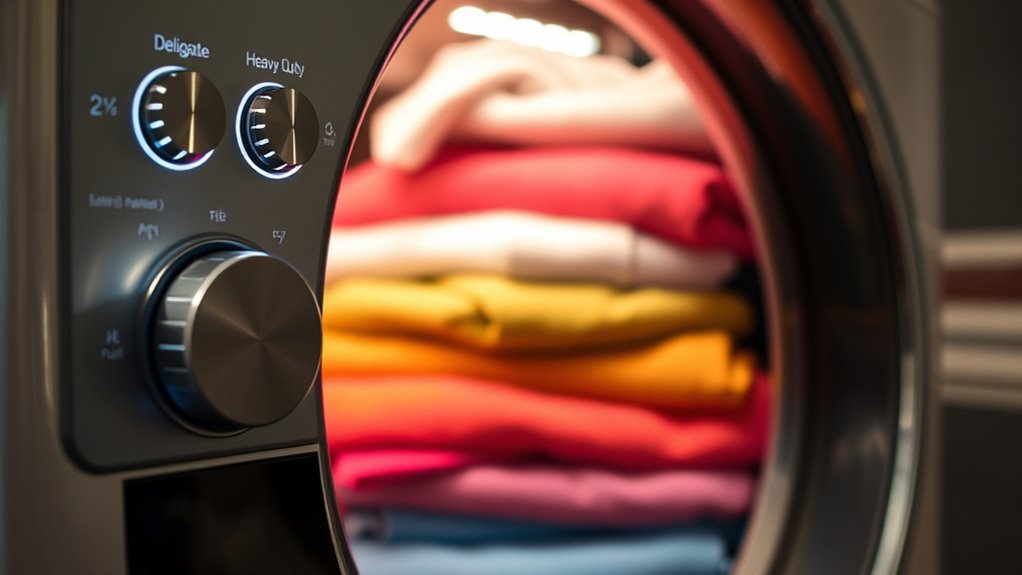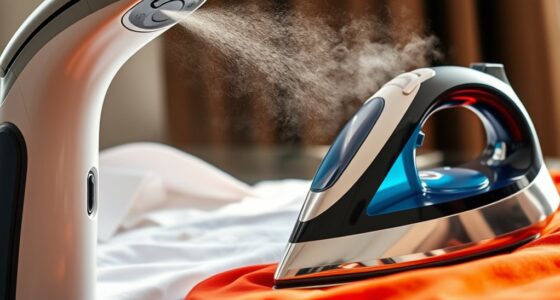To avoid ruining your clothes, choose the right dryer cycle for each fabric. Use delicate or no-heat settings for fragile items like silk and lace, and opt for permanent press to reduce wrinkles efficiently. Utilize moisture sensors for ideal drying without overdoing it, and try steam cycles for freshening or wrinkle reduction. Properly maintaining your dryer keeps it running smoothly, but mastering these settings will help your clothes last longer and look better. Keep going to discover all the tips!
Key Takeaways
- Select delicate or no-heat cycles for fragile fabrics to prevent damage and extend garment life.
- Use moisture sensors and avoid over-drying to prevent shrinking, fading, and wear.
- Match cycle temperatures and settings to fabric type—low heat for silk, medium for synthetics.
- Regularly clean lint filters and sensors to maintain dryer efficiency and fabric safety.
- Utilize specialized cycles like steam or air fluff for refreshing without risking heat damage.
Understanding Your Dryer Cycle Options

Understanding your dryer cycle options helps you choose the right setting for each load, protecting fabrics and saving energy. Dryer cycles vary in temperature, tumbling style, and features to optimize drying efficiency and clothes care. The delicate cycle uses low heat, ideal for fragile fabrics like silk and lace, preventing damage. The permanent press or wrinkle-resistant cycle combines medium heat with cooling phases to reduce wrinkles and maintain fabric texture. Modern dryers often feature moisture sensors that detect when clothes are dry, stopping the cycle automatically to prevent over-drying and shrinking. Some cycles incorporate steam or sanitize functions, offering wrinkle reduction and odor elimination. By selecting the appropriate drying options, you extend your clothes’ lifespan and keep them looking their best while conserving energy.
When to Use the No-Heat or Air Fluff Setting
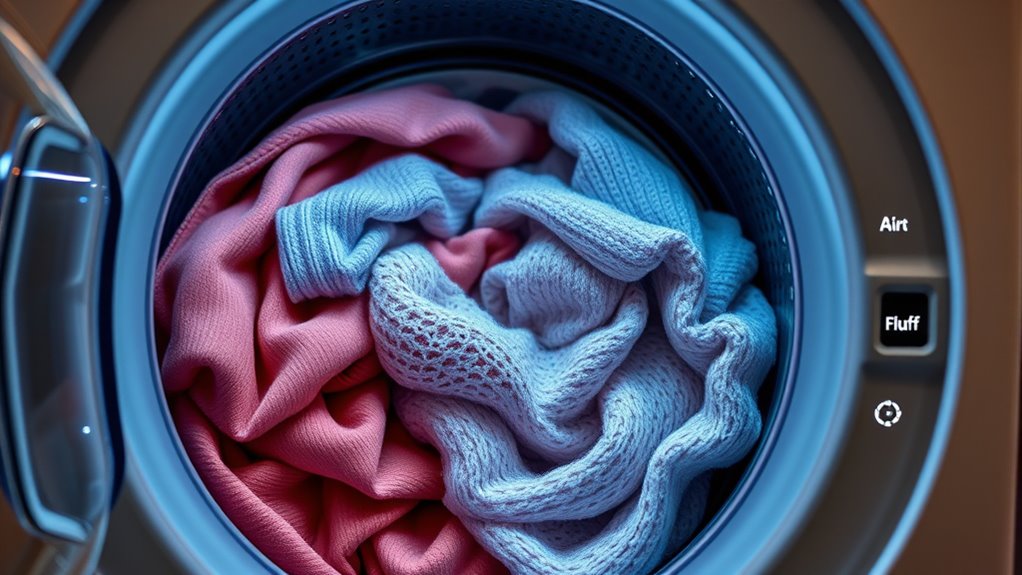
You should use the no-heat or air fluff setting when you want to refresh or soften clothes without risking damage from heat. This cycle circulates room-temperature air, making it perfect for delicate fabrics like silk, lace, or embellished garments that could be harmed by heat. Use air fluff to remove dust, pet hair, and wrinkles from dry clothes that don’t need full drying. It’s also great for softening or fluffing clothes that are already dry but feel stiff. Keep in mind, this setting doesn’t dry or de-wrinkle damp or wet clothes, so avoid using it for those. Typically lasting 15-20 minutes, no-heat or air fluff cycles help maintain your clothes’ appearance and texture safely. Regular use of the air fluff cycle can also help prevent clothes from developing musty odors caused by moisture buildup. Additionally, understanding the different dryer settings can help you choose the best cycle for each load. Knowing how to properly use these settings can also extend the lifespan of your garments by reducing unnecessary heat exposure. Incorporating proper laundry practices, such as sorting clothes by fabric type, can further optimize drying results and preserve your garments longer.
Choosing the Right Cycle for Delicate Fabrics
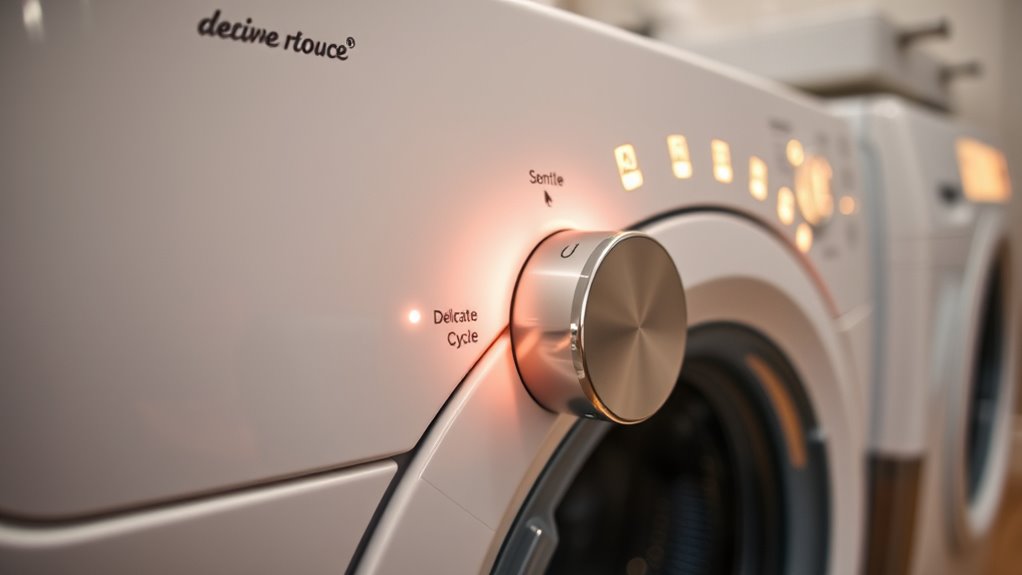
When drying delicate fabrics like silk, lace, or chiffon, selecting the appropriate cycle is essential to prevent damage. Use the gentle cycle, which employs low heat—around 125°F—to protect fabric integrity. This drying cycle is designed for fabric care, reducing the risk of shrinking, stretching, or melting. For added protection, place delicate items in mesh laundry bags before drying to prevent snagging or stretching. If your dryer offers no-heat options, like air fluff or steam cycles, use them for extremely sensitive or dry-clean-only fabrics. Avoid high heat settings, as excessive heat can harm delicate fabrics during the drying process. Choosing the right cycle guarantees your fragile garments stay looking their best, extending their lifespan and maintaining their original quality. Incorporating fabric care techniques such as proper drying methods can also help preserve garment longevity and appearance.
Maximizing Efficiency With Permanent Press and Wrinkle-Resistant Cycles
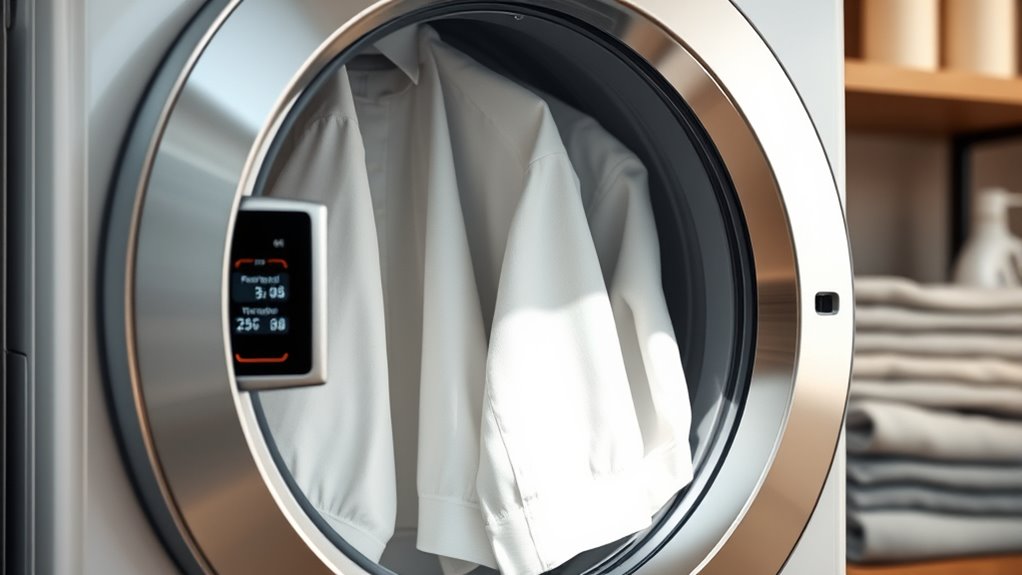
After choosing gentle cycles for delicate fabrics, optimizing your dryer settings can further streamline laundry care. The permanent press cycle, or wrinkle-resistant setting, uses medium heat and a cool-down period to prevent wrinkles and protect fabric fibers. This cycle is especially effective for synthetic fabrics like polyester blends, helping relax fibers and reduce the need for ironing. The cool-down phase gradually lowers temperature, preventing new wrinkles from forming and ensuring clothes stay smooth. Proper use of this cycle extends garment longevity and preserves color vibrancy, making laundry maintenance more efficient. By selecting the right cycle, you improve drying efficiency and safeguard your clothes from unnecessary wear. Incorporating the permanent press or wrinkle-resistant cycle into your routine maximizes clothes protection and saves time on post-drying touch-ups.
How the Automatic or Sensor Dry Works
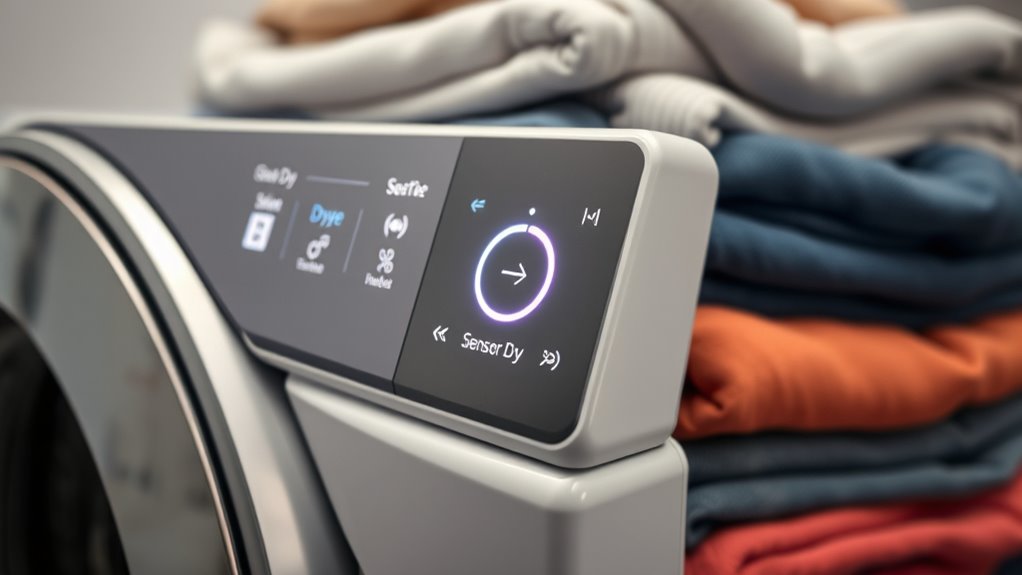
Automatic or sensor dry cycles utilize moisture sensors embedded in the dryer to detect when clothes reach the desired dryness level. These moisture sensors monitor moisture and temperature in real-time, allowing the dryer to adjust drying time automatically. Sensor dry cycles help prevent over-drying, which can damage fabrics and cause shrinkage, while also promoting fabric preservation. Since the sensors detect moisture accurately, they reduce unnecessary drying, improving energy efficiency. Regular sensor maintenance, like cleaning lint filters and sensors, ensures ideal moisture detection and performance. When functioning properly, sensor dry cycles save you time, protect your clothes, and lower energy costs. This smart system takes the guesswork out of drying, giving you perfectly dried clothes without the risk of over-drying or wasting energy. Proper placement of the dryer and filter maintenance are essential for the sensors to work effectively. Additionally, proper sensor calibration can enhance drying accuracy and efficiency. Ensuring the sensors are free from dust and lint buildup is crucial for maintaining their accuracy, which directly impacts drying performance. Using high-quality moisture sensors can further improve the reliability of sensor dry cycles and prolong the lifespan of your dryer.
The Benefits of Timed Dry and When to Select It
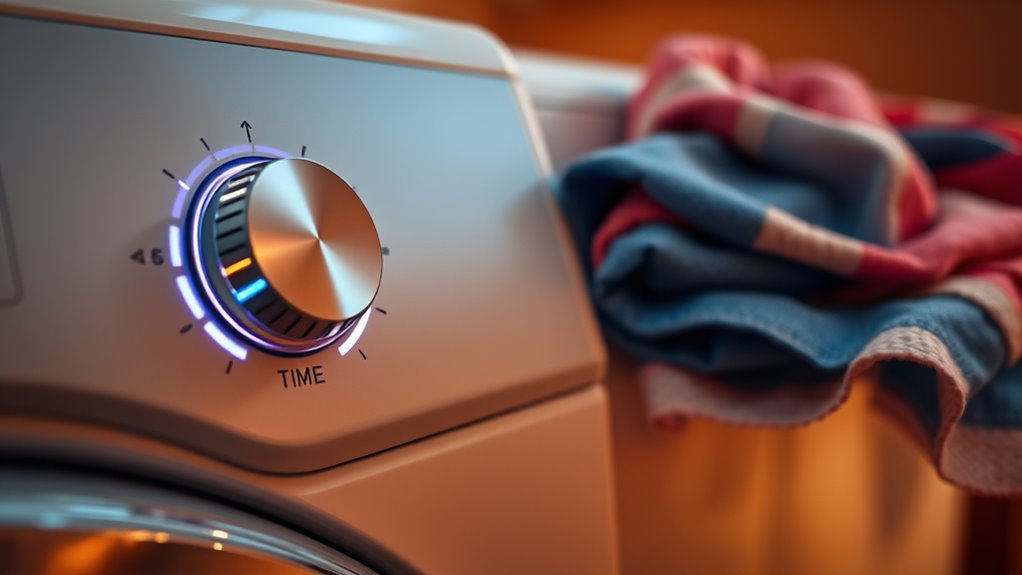
Timed dry gives you precise control over the drying process, so you can avoid over-drying delicate or bulky items. It’s perfect for specific fabrics or when you want to stop and check progress. Plus, it can save energy and time by limiting the cycle duration for small loads or quick-drying fabrics. Incorporating organized space into your laundry routine can also help you efficiently manage your drying tasks and prevent clutter buildup. Additionally, understanding how contrast ratio affects image quality can help you choose the right settings to optimize your drying results. Selecting the appropriate dryer settings ensures your clothes maintain their quality and longevity, and exploring options like ECU remapping can further enhance appliance efficiency. Moreover, awareness of machine learning techniques can improve the way modern appliances adapt to your habits, making drying more efficient and tailored to your needs.
Precise Drying Control
Precise drying control with timed dry gives you the ability to set a specific duration for your laundry cycle, typically from 10 to 60 minutes. This feature lets you customize your drying time, bypassing moisture sensors that might misjudge bulky fabrics like towels or bedding. Using timed dry helps prevent over-drying and shrinkage, especially for delicate items that require careful handling. It’s also useful for finishing items that need a quick touch-up or for sanitizing cycles that benefit from a controlled dry time. Keep in mind, since timed dry bypasses moisture sensors, it may use more energy and risk over-drying if not monitored closely. Understanding dryer settings can help you make the most of this feature and avoid common pitfalls. Additionally, being aware of water temperature options can further optimize your drying results for different fabrics and needs.
Ideal for Specific Items
Wondering when to choose the timed dry setting? Timed dry is perfect for bulky items like bedding and towels that need extra time or when moisture sensors fail, ensuring quick drying within a set period. It’s also ideal for fabrics that tolerate high heat, such as denim or workwear, providing custom drying control. Use it to prevent over-drying delicate fabrics, protecting clothes from shrinkage and fading. Additionally, timed dry is handy when you want clothes slightly damp for ironing or finishing touches. Being aware of drying settings can help you achieve optimal results and extend the life of your garments. Recognizing how natural language processing influences overall well-being may inspire more mindful and intentional laundry habits, aligning your daily routines with your personal growth. Cultivating a home environment that supports positive energy can enhance your overall laundry experience and promote a sense of harmony. Moreover, understanding the AI-driven innovations in household appliances can lead to smarter, more efficient laundry routines.
Saves Energy and Time
Using the timed dry setting can notably save energy and reduce drying time, especially when you need to avoid over-drying. By setting specific drying cycles, you prevent unnecessary energy consumption and shorten the drying time for small or quick-drying loads. Timed dry is ideal for bulky or heavy items like towels and bedding, ensuring ideal moisture removal without overexposing fabrics. It also helps protect delicate fabrics from damage caused by prolonged heat exposure. When moisture sensors malfunction, timed dry guarantees consistent results. Shorter drying cycles help conserve energy, making your laundry more efficient. Selecting the right timed dry setting balances drying speed and clothes protection, ultimately saving you time and energy while maintaining your garments’ integrity. Focusing on emergency preparedness essentials can help you develop routines that include proper laundry maintenance during crises, ensuring your clothes remain in good condition even in challenging situations.
Refreshing Clothes With the Steam Cycle
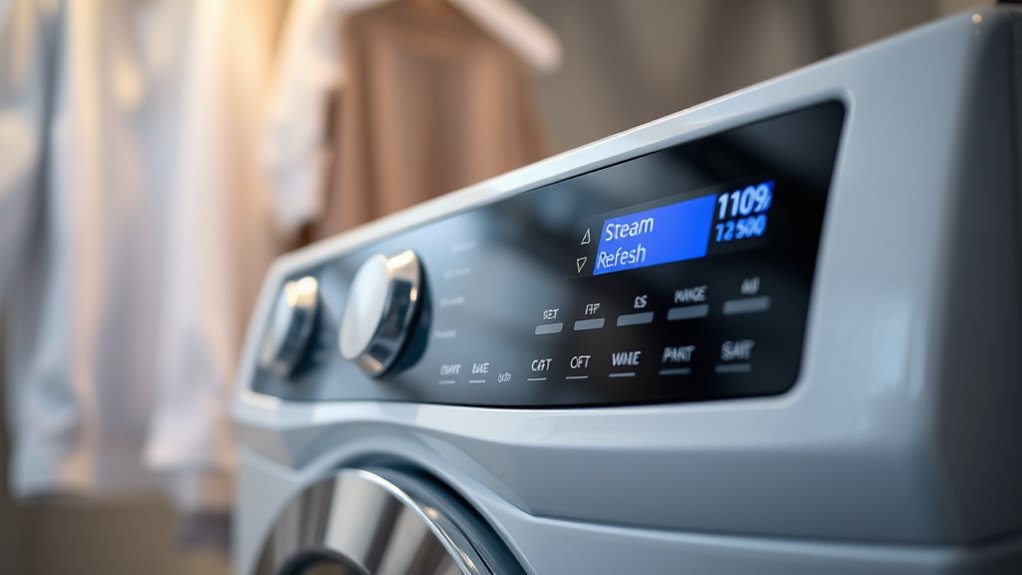
The steam cycle offers an effective way to invigorate your clothes without fully drying them, using moisture and gentle tumbling to reduce wrinkles and eliminate odors. This cycle is perfect for refreshing garments worn once or twice, especially delicate fabrics, without exposing them to high heat or damage. It softens clothes and restores their appearance while reducing wrinkles, making clothes look and feel newer. The steam cycle also helps eliminate odors, keeping your wardrobe fresh longer. Plus, it’s a quick, energy-efficient way to maintain clothes between washes. Keep in mind, it requires a water connection and regular maintenance to prevent clogs and ensure ideal performance. Overall, the steam cycle is a gentle, effective method for clothes maintenance, prolonging the life of your delicate fabrics.
Special Dryer Features and Advanced Settings

Modern dryers come equipped with a variety of advanced features and settings that enhance convenience and protect your clothes. Moisture sensors automatically detect when your laundry is dry, preventing over-drying and fabric damage. The delicate setting ensures gentle handling of fragile items, while steam cycles reduce wrinkles and refresh clothes. Smart app compatibility lets you customize cycles, monitor progress, and receive alerts remotely. Voice activation allows hands-free control through smart home devices. Eco-friendly models, certified by ENERGY STAR, utilize technologies like EcoBoost to cut energy use by up to 30%. These advanced dryer features make laundry more efficient and gentle. Here’s a quick overview:
| Feature | Benefit | Usage |
|---|---|---|
| Moisture sensor | Prevents over-drying | Automatic cycle adjustment |
| Steam | Reduces wrinkles, refreshes clothes | Gentle, quick touch-up |
| Smart app | Remote monitoring and control | Cycle customization, alerts |
Tips for Properly Maintaining Your Dryer and Extending Its Life
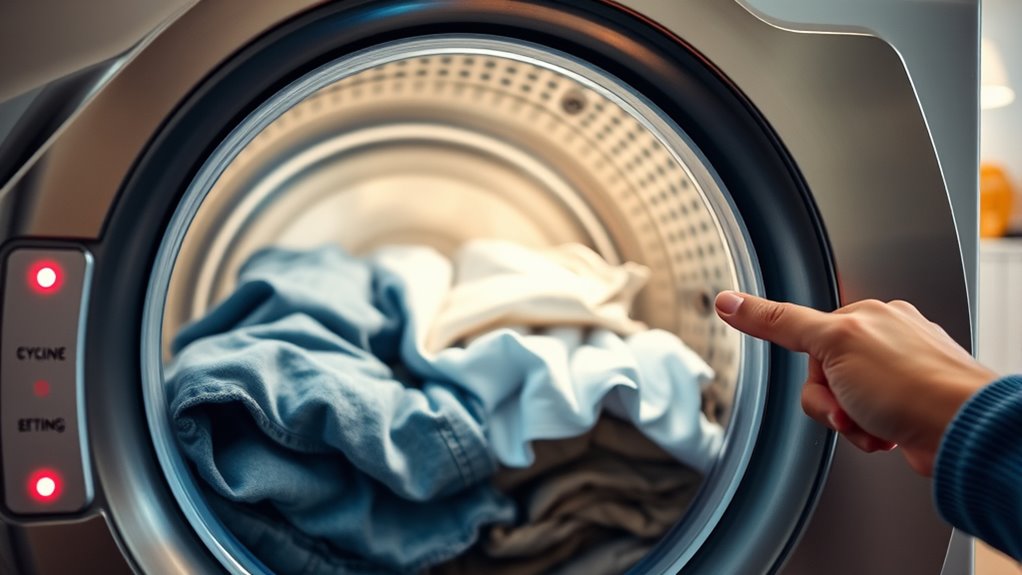
Proper maintenance is essential to keep your dryer running efficiently and prevent costly repairs. Start by cleaning the lint trap after every load to stop lint buildup and guarantee proper airflow, which can also reduce fire hazards. Inspect and clean dryer vents and ductwork at least once a year to prevent overheating and maintain drying performance. Check door seals and filters regularly for damage or wear, replacing them as needed to avoid moisture leaks. Use the correct cycle and heat settings tailored to fabric types; this minimizes wear on clothes and your dryer. Additionally, schedule professional maintenance annually to calibrate moisture sensors and clean internal parts. These steps help extend your dryer’s lifespan, keep it functioning at its best, and save you money in the long run.
Frequently Asked Questions
What Is the Best Dryer Setting to Not Damage Clothes?
If you’re worried about damaging your clothes, choose the right dryer setting. Use the “Delicate” or “Gentle” cycle with low heat for fragile fabrics, and the “Permanent Press” cycle to reduce wrinkles and wear. Avoid high heat and timed cycles, which can cause melting or stretching. For ultra-sensitive items, try “Air Fluff” or “Air Dry” to prevent heat damage altogether. This way, your clothes stay in great shape.
Why Does My Dryer Make My Clothes so Staticy?
They say a chain is only as strong as its weakest link, and static in your clothes shows how heat and dry air weaken fibers. When you use high heat and dry clothes completely, static electricity builds up. To fix this, try using dryer sheets, fabric softeners, or moisture-absorbing balls. Opt for no-heat cycles or add a damp cloth to keep humidity levels balanced, reducing static cling effectively.
What Is the Least Damaging Dryer Setting?
The least damaging dryer setting is usually the “No-Heat” or “Air Fluff” cycle, which uses room-temperature air to tumble your clothes gently. If that’s unavailable, choose the “Delicate” or “Gentle” cycle, as they use low heat to protect fragile fabrics. Steam cycles are also gentle options, reducing wrinkles without high heat. Using moisture sensors on automatic cycles helps prevent over-drying and fabric damage.
What Setting Should Synthetics Be on in a Dryer?
Isn’t it true that choosing the right dryer setting can be the difference between keeping your clothes vibrant and watching them fade? For synthetics, you should use the Permanent Press or Wrinkle-Resistant cycle, which employs medium heat. This prevents melting or damage. If your fabrics are fragile, opt for the Delicate or Gentle cycle with low heat. Always check the care label and avoid high heat to protect your synthetics.
Conclusion
By mastering your dryer’s settings, you’ll gently guide your clothes to their best look and feel, almost like giving them a quiet retreat. A little know-how goes a long way in preventing wear and tear, ensuring your wardrobe stays fresh and vibrant. With these tips, you’ll turn everyday drying into a mindful ritual, letting your garments enjoy a longer, happier life—without ever having to say goodbye too soon.
